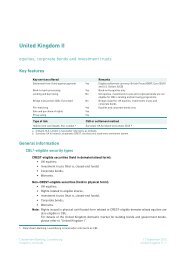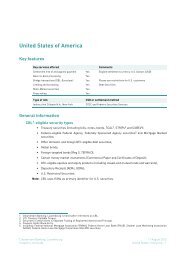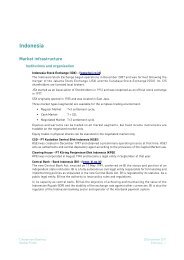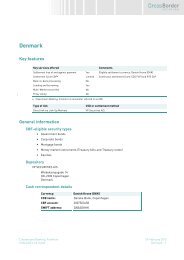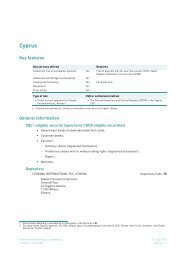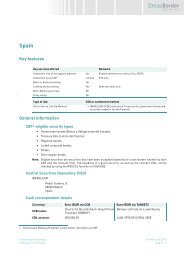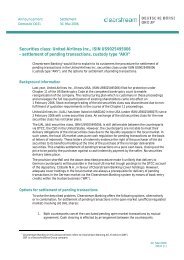An introduction to the European Post-Trade Market - Clearstream
An introduction to the European Post-Trade Market - Clearstream
An introduction to the European Post-Trade Market - Clearstream
You also want an ePaper? Increase the reach of your titles
YUMPU automatically turns print PDFs into web optimized ePapers that Google loves.
Issuers can decide “what” and “where” <strong>to</strong> issue. For equities, <strong>the</strong>y usually choose a securities type<br />
provided by <strong>the</strong>ir domestic legal regime (“what”) and register it with <strong>the</strong>ir domestic CSD (“where”).<br />
For bonds, <strong>the</strong>y have many choices. Today, more and more bonds in Europe are issued as international<br />
bonds (exhibit 6). 34)<br />
International bonds are primarily bonds which are not only placed with domestic but also with nondomestic,<br />
mostly institutional inves<strong>to</strong>rs. When an issuer decides <strong>to</strong> issue an international bond, he<br />
usually decides <strong>to</strong> issue it as a bond under applicable domestic law and <strong>to</strong> deposit it with his domestic<br />
CSD. In this case, <strong>the</strong> CSD provides <strong>the</strong> safekeeping and notary functions. Or he may decide <strong>to</strong> issue<br />
it as a Eurobond. In this case, a common deposi<strong>to</strong>ry provides <strong>the</strong> safekeeping; an ICSD, <strong>to</strong>ge<strong>the</strong>r with<br />
a common deposi<strong>to</strong>ry, provides <strong>the</strong> notary function. Both ways of issuance substitute each o<strong>the</strong>r. The<br />
choice is driven by <strong>the</strong> issuer’s issuance cost and <strong>the</strong> preference of bond inves<strong>to</strong>rs, which is in turn<br />
largely driven by <strong>the</strong>ir post-trade preferences.<br />
4.1 Competition for post-trade services<br />
THE EUROPEAN POST-TRADE MARKET<br />
Competition, Efficiency, and Governance<br />
The following discussion focuses on competition for post-trade services in cash markets. <strong>Post</strong>-trade<br />
functions are <strong>the</strong> same for bonds and equities and do not differentiate between on-exchange or<br />
over-<strong>the</strong>-counter transactions. Every post-trade function is offered by a number of different post-trade<br />
services providers and is open <strong>to</strong> competition. To understand <strong>the</strong> competitive dynamics in post-trade<br />
services, one needs <strong>to</strong> differentiate between clearing and settlement, cus<strong>to</strong>dy, safekeeping and <strong>the</strong><br />
notary function.<br />
Exhibit 7: <strong>Trade</strong>s on and off exchanges in Europe<br />
Figures for 2003, in %<br />
Number of transactions<br />
Value of transactions<br />
On-exchange<br />
OTC 1)<br />
On-exchange<br />
OTC 1)<br />
Equities Bonds Total<br />
1) Over <strong>the</strong> counter; does not include internalisation by banks or direct physical exchange<br />
10<br />
30<br />
Source: World Federation of Exchanges (www.world-exchanges.org), Deutsche Börse AG in-house analysis, 2004<br />
70<br />
90<br />
34) On <strong>the</strong> definition of international and domestic debt securities used in exhibit 11 see Bank for International Settlements, 2003, p.13.<br />
Debt securities include bills, but exclude money-market instruments. International debt securities include Eurobonds.<br />
15<br />
25<br />
75<br />
85<br />
25<br />
35<br />
65<br />
75<br />
21






